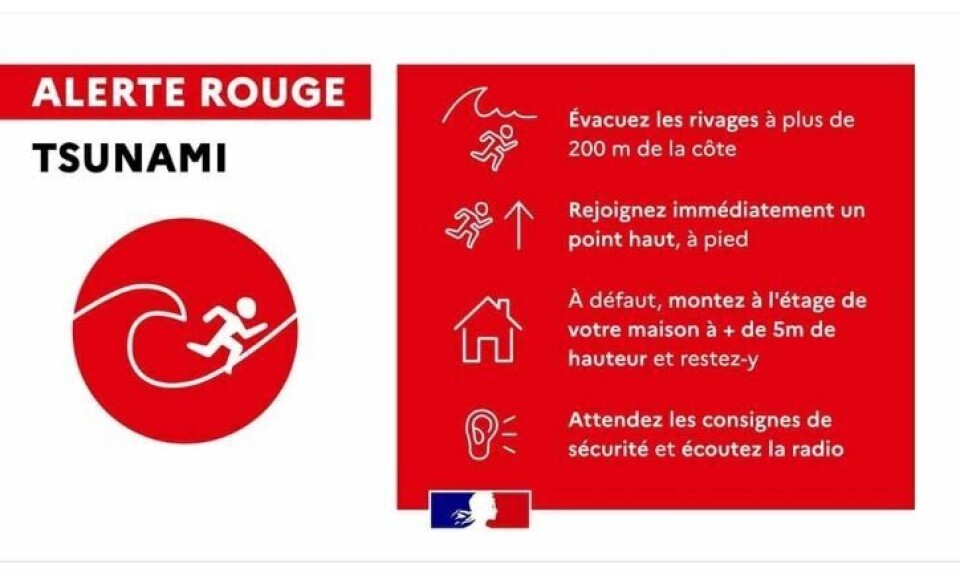-
Festivals, holidays and places to visit in France in April 2025
Including a gladiator battle in a Roman arena, an international garden festival and the Paris marathon
-
Many Société Générale customers to be charged additional fees from April
There is some good news for international banking and instant transfers, however
-
Why gas prices in France are rising in April - and by how much
It comes after six consecutive monthly rises. Try these tips to reduce your bills
Relief as tsunami alert in southern France turns out to be a mistake
The ‘red alert’ warning asked residents to evacuate coastal areas

Locals in southern France with a regular eye on social media breathed a sigh of relief after a tsunami alert turned out to be an error.
The prefecture in Var - which sits between Nice and Marseille - posted the warning on Tuesday (June 6) afternoon.
The red-alert-level warning on Twitter for an incoming tsunami told people to move at least 200 metres inland.
But the prefecture quickly announced the post had been made in error.
The message was part of an internal exercise and was not supposed to be shared on social media sites.
Despite the usually calm waters of the Mediterranean, southern France has experienced tsunamis in the past, including in 1979.
Scientists have predicted the area will almost certainly see a tsunami in the coming years too.
Tsunami warning quickly retracted
The post was shared around 14:30 on the prefecture’s official social media pages, such as Twitter.
It was labelled as a ‘red alert’ warning, with information explaining what residents in the area must do.
The list included instructions to:
- Evacuate shorelines and move at least 200 m away from the coast
- Immediately walk to a high point or go upstairs in your house to a height of more than 3 m and stay there
- Wait for instructions from the authorities, and listen to the radio
Within ten minutes, the prefecture updated its post to say the information had been shared in error. It was produced as part of an internal exercise and was not supposed to be broadcast to the public.
The time frame still allowed for a number of residents of the area to see the warning, leading to some panic.
One resident said she was peacefully drinking coffee but “immediately started thinking about what to do,” to protect her family after being told of the announcement by her son.
“It's a bit like being a first aider, I suppose. There's something going on, what are the priority things to do urgently? We decided to turn on a local radio station while getting ready to climb onto the roof if necessary," she said.
Despite the initial fear caused by the mistake, however, she is not angry about it.
“I'd rather receive false alerts and go to safety if necessary than miss out on some important information. Maybe it will save my life one day,” she added.
Read also: How does France's new wildfire risk forecast work? Where can I see it?
Tsunamis possible in the Mediterranean
Although a real red alert for a tsunami would be a shock to residents, the appearance of a tsunami in the usually wave-less Mediterranean is not to be unexpected.
Around 10% of all tsunamis take place in the Mediterranean, says seismologist Pascal Roudil.
Although many of these are small, there have been instances of larger and more dangerous disasters throughout history.
In 1979, a tsunami (possibly caused by construction works at the Nice airport) killed up to 23 people in the area, and waves up to a height of 3.5 metres were recorded in Antibes.
The chance of a tsunami in the Mediterranean within the next thirty years is “almost 100%,” says UNESCO, and in France, all of the Mediterranean shore is classed as being under threat from the phenomenon.
Even a large tsunami from an earthquake would be less powerful than in the Pacific, but could still cause devastation, with waves of even 50cms in height able to move cars dozens of metres away from their original location.
Is France protected against tsunamis?
France has invested money into early warning detection systems that will give authorities up to an hour to evacuate beaches and areas close to the waves in the event of a tsunami, depending on the location of the preceding earthquake.
For a maximum ‘red alert’ scenario (such as the one mistakenly shared by the authorities), people would generally be safe if they move 200 metres inland, and stay 5m above sea level, where possible.
In February 2023, Cannes (Côte d'Azur) installed a digital terminal informing residents of tsunami risks.
Related articles
France’s Mediterranean coast at risk of tsunami within next 30 years
Storms set to end record-breaking dry spell in northern France
























